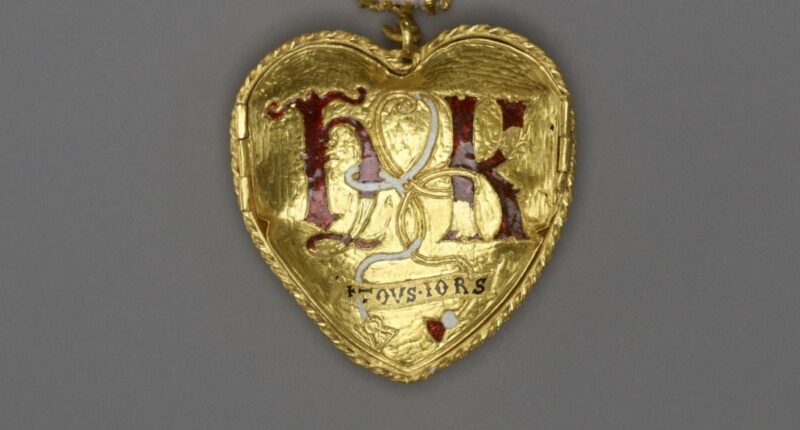Share this @internewscast.com
A spectacular gold pendant linked to Henry VIII’s marriage to Katharine of Aragon could be saved for the nation – but it will come at a hefty price.
The artefact, inscribed with the letters ‘H’ and ‘K’, was discovered in 2019 by a cafe owner in Birmingham who had only been using his metal detector for six months.
The detectorist, Charlie Clarke, stands to become a millionaire if the British Museum’s effort to raise £3.5 million to purchase the pendant at market value is successful.
The Museum today launches a bid to save the ‘Tudor Heart’ with the help of funds from the general public.
Experts from the Museum have determined that the 24-carat gold artefact may have been crafted for a tournament in October 1518 celebrating the betrothal of Henry VIII’s and Katharine’s daughter, Princess Mary, to the French heir apparent.
Henry regularly commissioned London goldsmiths to create costume jewellery for major celebrations and state occasions.
They were worn briefly by members of the court to create the impression of great splendour.
The pendant unites the Tudor rose with Katherine’s pomegranate symbol, and features a banner that reads ‘tousiors’, the old French for ‘always’.

A remarkable gold pendant associated with Henry VIII’s marriage to Katharine of Aragon might be preserved for the nation, though at a significant cost. This extraordinary artefact was found in 2019 by a cafe owner from Birmingham.

According to research carried out by Museum experts, the 24-carat gold artefact may have been created for a tournament in October 1518 to celebrate the betrothal of Henry VIII’s and Katharine’s daughter, Princess Mary, to the French heir apparent.
After it was found in a Warwickshire field, the pendant was reported under the Treasure Act 1996.
Per the Act, any object declared treasure becomes the property of the Crown and is safeguarded so museums or galleries in England have the opportunity to acquire it.
The proceeds of the purchase are typically shared with the person who found it and the landowner. Mr Clarke could therefore be set for a £1.75million windfall.
Speaking about his discovery in 2023, Mr Clarke told The Guardian: ‘I had found a few coins before, nothing special. But I knew it was gold.
‘When you see that colour then that is what you are there for as a metal detectorist.’
His ‘once in 30 lifetimes’ find caused him, he said, to shriek ‘like a little schoolgirl’.
Ironically, the pendant is currently being held for safekeepering by the British Museum itself.
It it will be on display from this week for the rest of the fundraising campaign.
The Museum needs to raise the money by April 2026. It has already received a £500,000 donation from the Julia Rausing Trust.

Mr Clarke (left) is seen looking at the pendant at the British Museum alongside Tory arts minister Lord Parkinson, January 2023


Henry VIII was married to Katharine of Aragon for 24 years. He ditched her in favour of Anne Boleyn

The Museum today launched a bid to save the ‘Tudor Heart’ with the help of the public

After it was found in a Warwickshire field, the pendant was reported under the Treasure Act 1996
If it can’t raise the money, the pendant will be open for purchase by a private collector.
Nicholas Cullinan, director of the British Museum, said: ‘The Tudor Heart is perhaps one of the most incredible pieces of English history to have ever been unearthed.
‘Support will ensure that this unique and beautiful treasure is secured for the nation, so that it can be enjoyed by and inspire generations to come.’
Simon Fourmy, chief executive of The Julia Rausing Trust, said: ‘We are delighted to support the British Museum in acquiring the Tudor Heart for the nation.
‘This remarkable pendant sheds light on a defining royal marriage and enriches our understanding of the Tudor world.
‘We hope others will be as inspired by this extraordinary object as we were, and will join us in giving generously to ensure this treasure remains on view for many years to come.’

Ironically, the pendant is currently being held for safekeepering by the British Museum itself

The Museum needs to raise the money by April 2026. It has already received a £500,000 donation from the Julia Rausing Trust
A public campaign is now open for donations, while the object will go on display in the museum’s gallery two until April 2026.
Henry tied the knot with Katherine in 1509 and the couple were married for 24 years.
But Katharine fell out of favour with the King because of her failure to give birth to a male heir.
She had six children but only the future Queen Mary survived.
Henry then turned his affections on Katharine’s lady-in-waiting, Anne Boleyn.
He caused a split with the Catholic Church in Rome when he had his first marriage annulled so he could marry Anne.
During their three-year union, Anne gave birth to daughter Elizabeth but also failed to produce a male heir. She was beheaded after being accused of treason.
Henry would go on to have four more wives.

















